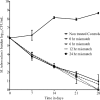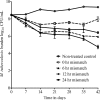Pharmacokinetic mismatch does not lead to emergence of isoniazid- or rifampin-resistant Mycobacterium tuberculosis but to better antimicrobial effect: a new paradigm for antituberculosis drug scheduling
- PMID: 21896907
- PMCID: PMC3195047
- DOI: 10.1128/AAC.00269-11
Pharmacokinetic mismatch does not lead to emergence of isoniazid- or rifampin-resistant Mycobacterium tuberculosis but to better antimicrobial effect: a new paradigm for antituberculosis drug scheduling
Abstract
Multidrug resistant-tuberculosis is a pressing problem. One of the major mechanisms proposed to lead to the emergence of drug resistance is pharmacokinetic mismatch. Stated as a falsifiable hypothesis, the greater the pharmacokinetic mismatch between rifampin and isoniazid, the higher the isoniazid- and rifampin-resistant subpopulation sizes become with time. To test this, we performed hollow-fiber-system studies for both bactericidal and sterilizing effects in experiments of up to 42 days. We mimicked pharmacokinetics of 600-mg/day rifampin and 300-mg/day isoniazid administered to patients. Rifampin was administered first, followed by isoniazid 0, 6, 12, and 24 h later. The treatment was for drug-susceptible Mycobacterium tuberculosis in some experiments and hollow fiber systems with inoculum preseeded with isoniazid- and rifampin-resistant isogenic Mycobacterium tuberculosis strains in others. Analysis of variance revealed that the 12-h and 24-h-mismatched regimens always killed better than the matched regimens during both bactericidal and sterilizing effects (P < 0.05). This means that either the order of scheduling or the sequential administration of drugs in combination therapy may lead to significant improvement in microbial killing. Rifampin-resistant and isoniazid-resistant subpopulations were not significantly higher with increased mismatching in numerous analysis-of-variance comparisons. Thus, the pharmacokinetic mismatch hypothesis was rejected. Instead, sequential administration of anti-tuberculosis (TB) drugs (i.e., deliberate mismatch) following particular schedules suggests a new paradigm for accelerating M. tuberculosis killing. We conclude that current efforts aimed at better pharmacokinetic matching to decrease M. tuberculosis resistance emergence are likely futile and counterproductive.
Figures




Comment in
-
Pharmacokinetic mismatch of tuberculosis drugs.Antimicrob Agents Chemother. 2012 Mar;56(3):1666; author reply 1667. doi: 10.1128/AAC.06303-11. Antimicrob Agents Chemother. 2012. PMID: 22337897 Free PMC article. No abstract available.
Similar articles
-
Pharmacokinetic mismatch of tuberculosis drugs.Antimicrob Agents Chemother. 2012 Mar;56(3):1666; author reply 1667. doi: 10.1128/AAC.06303-11. Antimicrob Agents Chemother. 2012. PMID: 22337897 Free PMC article. No abstract available.
-
Intermediate Susceptibility Dose-Dependent Breakpoints For High-Dose Rifampin, Isoniazid, and Pyrazinamide Treatment in Multidrug-Resistant Tuberculosis Programs.Clin Infect Dis. 2018 Nov 13;67(11):1743-1749. doi: 10.1093/cid/ciy346. Clin Infect Dis. 2018. PMID: 29697766
-
Impact of nonlinear interactions of pharmacokinetics and MICs on sputum bacillary kill rates as a marker of sterilizing effect in tuberculosis.Antimicrob Agents Chemother. 2015 Jan;59(1):38-45. doi: 10.1128/AAC.03931-14. Epub 2014 Oct 13. Antimicrob Agents Chemother. 2015. PMID: 25313213 Free PMC article. Clinical Trial.
-
MDR Tuberculosis Treatment.Medicina (Kaunas). 2022 Jan 26;58(2):188. doi: 10.3390/medicina58020188. Medicina (Kaunas). 2022. PMID: 35208510 Free PMC article. Review.
-
Optimizing treatment outcome of first-line anti-tuberculosis drugs: the role of therapeutic drug monitoring.Eur J Clin Pharmacol. 2016 Aug;72(8):905-16. doi: 10.1007/s00228-016-2083-4. Epub 2016 Jun 15. Eur J Clin Pharmacol. 2016. PMID: 27305904 Review.
Cited by
-
Duration of pretomanid/moxifloxacin/pyrazinamide therapy compared with standard therapy based on time-to-extinction mathematics.J Antimicrob Chemother. 2020 Feb 1;75(2):392-399. doi: 10.1093/jac/dkz460. J Antimicrob Chemother. 2020. PMID: 31713607 Free PMC article.
-
Can phenotypic data complement our understanding of antimycobacterial effects for drug combinations?J Antimicrob Chemother. 2019 Dec 1;74(12):3530-3536. doi: 10.1093/jac/dkz369. J Antimicrob Chemother. 2019. PMID: 31504558 Free PMC article.
-
Meta-analysis of clinical studies supports the pharmacokinetic variability hypothesis for acquired drug resistance and failure of antituberculosis therapy.Clin Infect Dis. 2012 Jul;55(2):169-77. doi: 10.1093/cid/cis353. Epub 2012 Mar 30. Clin Infect Dis. 2012. PMID: 22467670 Free PMC article. Clinical Trial.
-
Poor Penetration of Antibiotics Into Pericardium in Pericardial Tuberculosis.EBioMedicine. 2015 Sep 16;2(11):1640-9. doi: 10.1016/j.ebiom.2015.09.025. eCollection 2015 Nov. EBioMedicine. 2015. PMID: 26870790 Free PMC article.
-
Fluoroquinolones and rifampin combination in the backdrop of heteroresistant tuberculosis.Antimicrob Agents Chemother. 2025 Feb 13;69(2):e0108424. doi: 10.1128/aac.01084-24. Epub 2025 Jan 16. Antimicrob Agents Chemother. 2025. PMID: 39817762 Free PMC article.
References
-
- Ahmad Z., et al. 2009. Biphasic kill curve of isoniazid reveals the presence of drug-tolerant, not drug-resistant, Mycobacterium tuberculosis in the guinea pig. J. Infect. Dis. 200:1136–1143 - PubMed
-
- Bangsberg D. R., et al. 2006. Adherence-resistance relationships for protease and non-nucleoside reverse transcriptase inhibitors explained by virological fitness. AIDS 20:223–231 - PubMed
-
- Bangsberg D. R., Kroetz D. L., Deeks S. G. 2007. Adherence-resistance relationships to combination HIV antiretroviral therapy. Curr. HIV/AIDS Rep. 4:65–72 - PubMed
-
- Benator D., et al. 2002. Rifapentine and isoniazid once a week versus rifampicin and isoniazid twice a week for treatment of drug-susceptible pulmonary tuberculosis in HIV-negative patients: a randomised clinical trial. Lancet 360:528–534 - PubMed
Publication types
MeSH terms
Substances
Grants and funding
LinkOut - more resources
Full Text Sources
Other Literature Sources
Molecular Biology Databases

